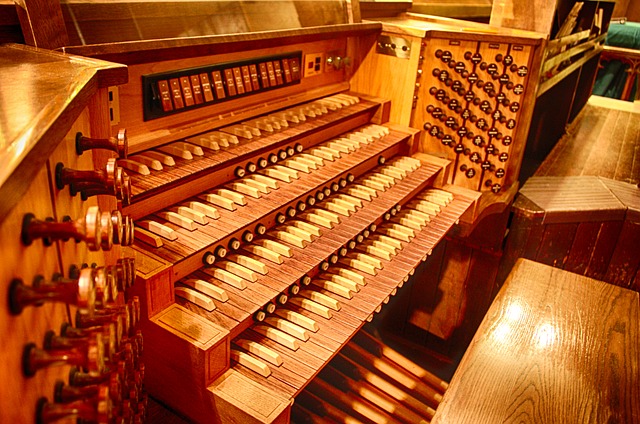Have you ever considered some of the differences between a piano and an organ?
The piano is a tuned percussion instrument. While I can play melodies and harmonies on the piano, the instrument produces sound by percussion; that is, the hammers strike the strings to set them vibrating. With 188 keys, this is a variation on the kettle or steel drums. The idea is the same: produce sound by striking something. Percussion instruments are those that are played by being struck by an object or the hand.
The organ, on the other hand, produces tones by blowing air across a pipe, similar to the way that you make sound blowing across the top of a Coke® bottle, except that in an organ the air crosses the bottom of the pipe rather than the top of the bottle. It is a completely different method of producing sound from the piano, and the two instruments have different timbres and uses. (I’m talking about pipe organs, not modern electronic organs.)

So, what does that have to do with the language classroom?
For me, there are a number of connections because I think that classroom teaching and corporate music making have a lot in common. (By “corporate” I don’t mean a business but a group of people working together as a body to accomplish a purpose.) However, my starting point for this post is student choral response.
I don’t know how things go in your classroom, but in my classes I occasionally encounter the following scenario:
My class is creating a story or having a conversation, and I want to make certain everyone understands and is following along. One of the ways I do this is to ask a question about a statement that was just made. The rules of engagement dictate that students respond in a way that shows comprehension or that indicates a need for clarification.
Let’s say I ask a yes-or-no question. Perhaps we’ve just said, “Bob goes to Mars.” I ask, “Does Bob go to Mars?” The entire class is supposed to show comprehension by answering “yes” or otherwise indicating agreement. Or else students indicate that they don’t understand. Instead, I get perhaps half a dozen students who respond. So I ask the question again. Perhaps ten students reply. I ask again. The same students reply. I ask again. The same students reply but are louder. I ask again. The same students reply and are now nearly shouting. The rest of the students remain unengaged.
Laut wie eine Orgel, nicht wie ein Klavier
At this point I stop class and remind students that I want “Laut wie eine Orgel, nicht wie ein Klavier” (Loud like an organ, not like a piano). If this is the first time I use the phrase, I explain the difference.

How do I make a piano louder? Remember, as a percussion instrument the piano creates sound by striking strings with a hammer. To make the sound louder, I strike the strings harder by pressing the piano keys harder. The harder I press or strike the keys, the louder the piano sounds. Eventually I may be “pounding” the keys to get a fortissimo or louder. This is what has been happening in the class: the same students have simply been getting louder. But I don’t want that. I want participation by more people, not just the same few people getting louder.
How do I make an organ louder?
I make an organ louder by adding voices. I can hold down a key and make the sound louder or softer by adding or subtracting voices through using the “stops” (knobs, levers, sliders, or buttons) on the organ. There are many different possible voices, from soft flutes through the strings to the reeds and even the Spanish trumpets. Each one has its own distinctive and unique sound.

The full organ – pulling out all the stops, including couplers – can be very loud, but it is because all voices are being heard, not just a few loud ones.
Every voice, every student, needs to make his or her own unique and distinctive contribution to the class’s creation.
That’s why I want my classes to be loud like an organ, not like a piano. Every voice, every student, needs to make his or her own unique and distinctive contribution to the class’s creation.
Check back later for more on the connection between music and teaching.
Note: This post originally appeared on my previous blog, “Robert’s Rambles”.
